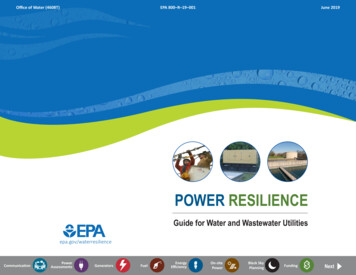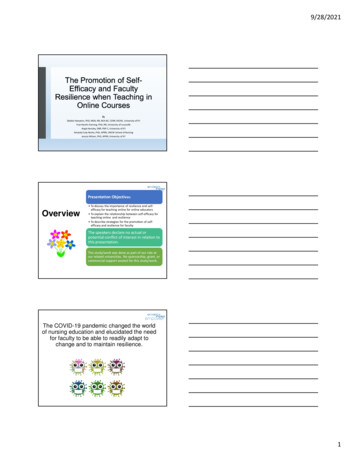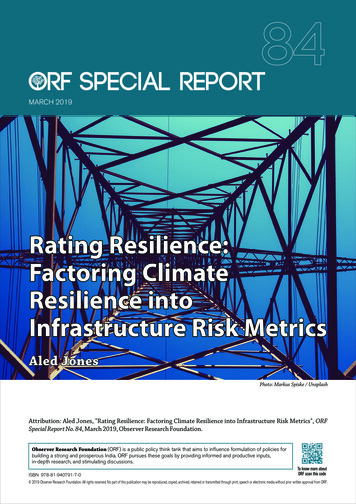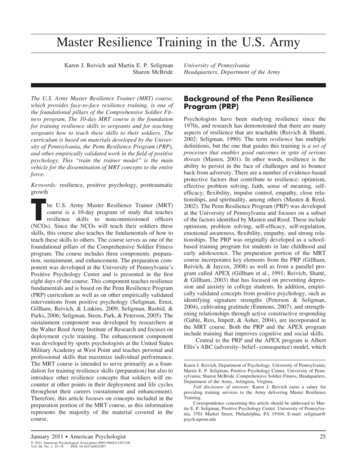
Transcription
Office of Water (4608T)EPA 800–R–19–001June 2019POWER RESILIENCEGuide for Water and Wastewater werBlack SkyPlanningFundingNext
OverviewThis guide includes information from water industryprofessionals on how to increase power resilience atdrinking water and wastewater utilities. The purpose of thisguide is to: Promote coordination and communication betweenwater sector utilities and their electric and gas utilities Provide information on how to build power resilienceusing generators, fuel supply planning, on-site power,microgrids and other methods Highlight case studies from water utilities that havesuccessfully implemented power resilience measures Identify planning considerations and resources forboth short (e.g., 2-3 days) and long (e.g., several weeks)duration power outagesPower loss can have devastating impacts on drinking water and wastewater utilities and the communities they serve.Inoperable pumps at a drinking water utility can make firefighting difficult and cause local health care facilities andrestaurants to close. Pressure loss can allow contaminants to enter the drinking water distribution system fromsurrounding soil and groundwater. For wastewater utilities, pump failure may lead to direct discharge of untreated sewageto rivers and streams or sewage backup into homes and businesses. Power loss can also impact water utilities throughcascading infrastructure failures. For example, a chemical plant without power could discharge contaminants into sourcewater sFuelEnergyEfficiencyOn-sitePowerBlack SkyPlanningFundingPreviousNext
Eight areas in which water sector utilities can increase power resilience are:1. Communication – Establish capability to communicate with electric providers, local agencies and the publicto help your utility respond more quickly and efficiently to a power loss.2. Power Assessments – Conduct a power assessment to understand your essential equipment energy needs.3. Emergency/Standby Generators – Learn how to select, maintain and register requirements for a fixed orportable emergency generator for your utility.4. Fuel – Develop plans to ensure you have enough fuel for your generator during a power outage emergency.5. Energy Efficiency – Increase your energy efficiency to allow you to operate on back-up power longer duringemergencies and to reduce your electricity bills during normal operations.6. On-site Power – Consider options for generating your own power.7. Black Sky Planning – Prepare for long-duration, widespread power outages.8. Funding – Learn about possible funding sources for resilience sFuelEnergyEfficiencyOn-sitePowerBlack SkyPlanningFundingPreviousNext
1CommunicationStep 1ContactsStep 2Key InformationStep 3Prioritization ListStep 4Training & ExercisesStep 5Public Outreach1. CommunicationTOP TIP: Get your utility on the priority list for power restoration.Good relationships, information sharing and collaboration between water and electric utilities and local emergencymanagement agencies (e.g., county, parish or city) are critical to having power restored quickly after an outage.Depending on the nature of the emergency and your local communication and response procedures, you may call yourelectric utility directly or you may need to coordinate through an emergency management agency (EMA). For moreinformation on working with your EMA, see the EPA’s Connecting Water Utilities and Emergency Management Agencies.Becoming familiar with your county’s emergency protocols and how response and recovery decisions are made,can help ensure that your utility is high on the power restoration prioritization list. Depending on your county’semergency protocols, the order in which power is restored to local critical infrastructure, such as your water utility,may be determined by your electric power provider, the local EMA or elected officials such as county commissioners.Communicate your emergency power needs and the consequences to the community should you have to ceaseoperations due to a power failure. This should include details regarding “minimum” power requirements for essentialfunctions only and any existing capabilities for back-up power and corresponding fuel requirements. Be sure you knowwho makes the power restoration prioritization list for your community and take steps to share relevant information withthem. You should also become aware of and involved in the total community restoration plan. Your assistance may beneeded to locate, prioritize and restore parts of the drinking water distribution system and wastewater collection systemthat serve critical infrastructure, such as mass care shelters.Did you know?When an electric utility is restoring service after a major outage, itgenerally prioritizes generating plants, transmission lines, substations,main circuits, critical customers, residential lines, transformers and thenindividual uelEnergyEfficiencyOn-sitePowerBlack SkyPlanningFundingPreviousNext
1CommunicationStep 1ContactsStep 1 – Make Contacts and Establish Emergency CommunicationsProtocol Get to know the key staff or points ofcontact at your electric utility responsiblefor power restoration prioritization.You may find that you have a dedicatedaccount representative who fulfills thisrole for your utility. If this is not the case,find that person who prioritizes yourrestoration. When possible, have face-toface meetings. Ask for 24/7 emergency contactinformation for the electric utility, thelocal EMA and the local EmergencyOperations Center (EOC) and save thesenumbers in your phone. Establish or verify, as applicable, theproper structure for the most efficientcommunications for power prioritizationand restoration. Make sure that thisstructure is National Incident ManagementSystem (NIMS) compliant.Step 2Key InformationStep 3Prioritization ListStep 4Training & ExercisesStep 5Public Outreach Ensure that your community’s emergencymanager has your contact information inhis or her cell phone so that when you call,your name will be recognized.Did you know?Many agencies and organizations share information and resourcesto support incident management activities at EmergencyOperations Centers (EOCs). EOCs focus on the response to andthe short-term recovery from an incident or natural disaster andprovide access for cross-sector key rsFuelEnergyEfficiencyOn-sitePowerBlack SkyPlanningFundingPreviousNext
1CommunicationStep 2 - Request Key Information Physical locations of critical assets. Make sure your electric utility has the physical locations (Global PositioningSystem (GPS) latitude and longitude in degrees-minutes-seconds or in decimal degrees of the location) of all criticalcomponents of your water or wastewater system, as the physical address of your facilities can differ from youradministrative address where bills are delivered. Give the physical address when reporting an outage. Also, requesta review of the corresponding electric grid infrastructure that supports your critical assets. Depending on how yoursystem is laid out, there may be different distribution feeders or substations for the treatment facility and individualpumping stations. Assess risks associated with the current electric power plan. Critical Interdependencies. You should also maintain situational awareness of activated, deactivated and nonactivated mass care facilities, 911 centers, and other critical infrastructure locations. There may be a need tocoordinate the restoration of electric power, water service and wastewater services to these assets. Communication Resources. Learn what communication resources, such as two-way radios or satellite phones, areavailable in your community. Be sure your radios are compatible with your response partners (e.g., P25 Standard).During a long-duration power outage, landlines and cellular phones may stop working. Conduct periodic tests withpartners to ensure communications interoperability. Make sure you understand the procedures and processes forcommunicating with your electric utility during an outage and during the recovery process. EOC street address. Know where your local EOC is so that you can send a liaison there during an emergency ifneeded. Mutual Aid Agreements. Share information about your membership in mutual aid agreements such as your state’sWater and Wastewater Agency Response Network (WARN). Access. Discuss what identificationrequirements or procedures are necessary toensure that utility staff can access critical assetsduring an emergency when there are roadclosures and security checkpoints.Step 1ContactsStep 2Key InformationStep 3Prioritization ListStep 4Training & ExercisesStep 5Public OutreachDid you know?Most EOCs have representatives from the electric utility, gasutility, transportation sector and other critical infrastructuresectors. During a disaster, call the EOC if you have troublecontacting your electric utility. Better yet, obtain a seat for yourutility at the EOC and you will be able to directly coordinate withthe electric utility, fuel and transportation neratorsFuelEnergyEfficiencyOn-sitePowerBlack SkyPlanningFundingPreviousNext
1CommunicationStep 1ContactsStep 2Key InformationStep 3Prioritization ListAmateur Radio Emergency ServiceThe Prince William County Service Authority has a great relationship with two local amateur radio clubs. Both clubshave their primary repeater sites on Service Authority property, including antennas on top of water towers. TheService Authority, county and radio clubs are working to establish alternative communications paths between theService Authority Department Operations Center (DOC), the Prince William County Emergency Operations Center(EOC) and the Service Authority’s Advanced Water Reclamation Facility. In November 2018, the Service Authorityand the Prince William County Amateur Radio Emergency Service (PWCARES) entered into a Memorandum ofUnderstanding (MOU) for emergency cooperation. During a widespread power outage when land lines andcellular phones may no longer work, amateur radio operators can provide vital communication services to theService Authority.Step 4Training & ExercisesStep 5Public FuelEnergyEfficiencyOn-sitePowerBlack SkyPlanningFundingPreviousNext
1CommunicationStep 1ContactsStep 3 – Get on the Priority Power Restoration List Learn how critical customers are managed and prioritized in your community. Engage the power restoration prioritization list manager. Determine your utility’s prioritization status and take additional measures to get as high on the priority list as possible. Inform the prioritization list manager of your “storm-ready” capabilities and be sure that he or she understands theconsequences to the community of drinking water and wastewater service disruptions and reduced service levels.Ensure the list manager understands how quickly water services can degrade without power and how long it takes torestore water services once power is lost. Inform the list manager of the critical assets at your utility that rely on grid power including their individual powerrequirements (e.g., critical functions vs. administration building). Gain an understanding of the other critical infrastructure facilities prioritized in the community so that you canalign water and wastewater supportaccordingly.Critical Customers Ask for annual updates to the criticalcustomer and prioritization lists.Step 2Key InformationStep 3Prioritization ListStep 4Training & ExercisesStep 5Public OutreachDominion Energy has worked closely with Virginia Emergency OperationCenters (EOCs) to identify the 10-20 most critical services in each of theEOC’s jurisdictions. Once identified, these critical facilitiesare further assigned Special Condition Categories, and water and sewagetreatment facilities are considered “Critical Infrastructure.” These“Special Conditions” accounts are flagged so Dominion knows instantlywhen a water or wastewater treatment facility loses power. An intranetapplication allows Dominion Energy to remain focused on these locationsto ensure critical infrastructure accounts receive the highest restorationpriority.In addition, during large-scale power outages, Dominion Energyestablishes Electric Regional Operations Centers to better manageits response. Water utilities have a direct line to these centers and torepresentatives of Dominion uelEnergyEfficiencyOn-sitePowerBlack SkyPlanningFundingPreviousNext
1CommunicationStep 1ContactsStep 2Key InformationStep 3Prioritization ListStep 4Training & ExercisesStep 5Public OutreachStep 4 – Planning, Training and ExercisesPlanning, training and exercises allow power and water utility staff to learn, practice, test and improve emergencyresponse plans (ERPs) and procedures. Often, these plans and procedures involve response partners. Consider thefollowing options to enhance the quality of your training and exercises: Plan with your electric utility to know how various power outage scenarios will affect your utility and what steps youcan take together to mitigate impacts. If your utility conducts planning activities or annual exercises, invite staff from your electric utility and local EMA.oThe EPA offers a Tabletop Exercise Tool for Water Systems to help utilities develop exercises for different scenarios.oThe EPA has also developed How to Develop a Multi-Year Training and Exercise (T&E) Plan to help water utilitiescreate successful training plans. Ask your electric utility to allow you to attend any exercises or planning activities it hosts. Participate in national exercises focused on grid resilience such as GRIDEX and EARTH EX. Ask your local EMA to include both your utility and the electric utility in its exercises. Share your emergency response plans with your electric utilityand EMA and ask for information and updates on their plans.Consider a dedicated planning component to emergency backup power (generators).Grid hardening - Activities such as tree-trimming help prevent weather related poweroutages. When talking to your electric utility,you can ask what grid hardening steps are beingtaken and what you can do to help. For example,do you have the resources to assist in treetrimming? If your water utility has a remotepump station in the woods serviced by electricpower from street lines, consider installing thatservice line underground along the access road.Although this is more expensive than typicalpole installation, the service line will be betterprotected from tree elEnergyEfficiencyOn-sitePowerBlack SkyPlanningFundingPreviousNext
1CommunicationStep 1ContactsStep 2Key InformationStep 5 – Communicating with the PublicDevelop a plan for how you will communicate boil water notices, water use restrictions and other information during apower outage. Many of the strategies below will only work during the first 24-48 hours of a power outage when cellulartowers still have back up or battery power. Consider approaches for reaching the public that would work even if landlines,cellular phones and the Internet are not working Appoint a communications manager or Public Information Officer who can assist in getting the correct messages outto your customers before, during and after emergencies. Contact local news and radio stations to broadcast your messages or post on their social media accounts. Ask the fire department, local EMA and municipal office to help with your public messages. They may already haveemergency communication systems such as reverse 911 in place. Check whether such systems would work for anextended period of time without power furnished by the electric grid. Develop an automated system to send emails and text messages to customers. Some areas may already have anemergency texting service that you can use. Post frequent, time-stamped updates on your utility’s website. Utilize social media by posting updated information with a Facebook or Twitter account. Collaborate with homeowners’ associationsto post signs near different communitygates and on community bulletin boards atthe Town or City Hall.Step 3Prioritization ListStep 4Training & ExercisesStep 5Public Outreach CommunicationPowerAssessmentsTrain communications personnel in Crisisand Emergency Risk Communications(CERC) and Message Mapping fortimely, accurate and productive crisiscommunications. The EPA offers numeroustools for Water Utility CommunicationDuring Emergency Response.GeneratorsFuelEnergyEfficiencyEye on the Weather - Weather services can usually forecast storms 24hours or more ahead of time. The EPA’s mobile app Water Utility ResponseOn-the-Go allows you to monitor and track all types of weather. For icestorms, you can also check the Sperry-Piltz Ice Accumulation Index (SPIAIndexTM), which gives a 0-5 ice accumulation and ice damage predictionindex. The SPIA IndexTM covers the continental United States and providespredictions days before a storm, including power outage durationpossibilities. In California, the Public Safety Power Shutdown (PSPS) is anoperational practice of shutting off the power to a limited area duringextreme and potentially dangerous weather conditions based on severalfactors such as red flag warnings, humidity levels and high wind conditions.Check to see if you have something similar in your state and ensure yourutility is closely coordinated with the agency issuing the PSPS.On-sitePowerBlack SkyPlanningFundingPrevious1-7Next
2Power AssessmentsStep 1AssessStep 2Document2. Power AssessmentsTOP TIP: Register your power assessment needs into the U.S. Army Corps of Engineers (USACE)Emergency Power Facility Assessment Tool (EPFAT) database.Power assessments determine your utility’s emergency power requirements for critical equipment to maintain waterand wastewater services. A power assessment team typically includes electrical, mechanical and operational subjectmatter experts. These are the appropriate utility professionals who can fully assess utilities’ power needs and operationalimplementation requirements. They will inspect all infrastructure assets at your utility. You will determine electrical assetscritical to your operation. Critical infrastructure components will be unique at each utility, but usually include treatmentprocesses and key pumping stations. This information is required to properly size an emergency generator(s), and areference to its location should be included in your ERP. You can learn more about power assessments and generatorsin the free, 2-hour online course, IS-815: ABCs of Temporary Emergency Power, offered by the Federal EmergencyManagement Agency (FEMA) Emergency Management rsFuelEnergyEfficiencyOn-sitePowerBlack SkyPlanningFundingPreviousNext
2Power AssessmentsStep 1AssessStep 2DocumentStep 1. – Conduct an Emergency Power Assessment at Your Utility Conduct a Self-Assessment – Perform your own emergency power assessment, with the assistance of a qualifiedpower assessment team. Consider Calling Prime Power – The USACE 249th Engineer Battalion may be able to provide free electric powerassessments for utilities. They can be reached at 800-243-3472 or 703-805-2562. When you upgrade your facilities or build new components, re-assess your power requirements to determine if youalso need to add generator capacity, battery banks or on-site renewable energy. Periodically review and update your emergency power requirements, especially when replacing assets and remodelingbuildings. Consider installing stationary generators with automatic transfer switches at all “critical” facilities to ensure they willstay in operation should the power go out. If possible, conduct a hydraulic model-based assessment of how performance measures would be impacted whenyour facility is powered by generators instead of the electric grid, and how failures of one or more generators wouldaffect torsFuelEnergyEfficiencyOn-sitePowerBlack SkyPlanningFundingPreviousNext
Step 2. – Keep Records of Your Assessment2Power AssessmentsStep 1AssessStep 2Document Maintain a copy of all information from the power assessment with your ERP, so you can easily locate it duringemergencies. You should have a summary of the power requirements, siting requirements, location and capacity ofany existing on-site generators at all critical infrastructure components. Generator-specific information requirements include the kilowatt, voltage and phase of the generator required. Theassessment should also include the electrical connection type, either delta or wye. Appendix A is an example of a Generator Information Sheet* that a utility could use for each of its generators. The assessment should include the GPS latitude and longitude in degrees-minutes-seconds or in decimal degrees ofthe location of any existing or needed generators. If possible, record any decimal degree GPS data values to the sixthplace to the right of the decimal point. The assessment should also include a basic order of materials with information on the number and length of cablesneeded to connect a generator to the utility’s electrical system, the number and size of lugs to connect the cable runs,and the number and designed location of grounding rods required. Input your generator information in the USACE EPFAT database. States and FEMA use this database during widespreadpower outages to quickly determine where and what kind of generators may be needed. When possible, use GPS toidentify the location of any existing generators. Enrollment in EPFAT is free. Keep your powerassessmentinformation up todate. The EPFATdatabase will remindyou every three yearsto review your data.* Clicking this link will open a MS Word document you can modify and/or elEnergyEfficiencyOn-sitePower2-3Black SkyPlanningFundingPreviousNext
3GeneratorsStep 1SizeStep 2OwnershipStep 3Fuel TypeStep 4ConnectionStep 5PlacementStep 6MaintenanceTips3. GeneratorsTOP TIP: Know what type of generators you need and where you would get them during a power outage.Choosing a GeneratorOnce you know your generator requirements, you need to make several decisionsto find the best one for your utility. A generator is classified by its power rating.Two distinct power ratings are prime power and emergency standby. The averageload factor for both types is 80 percent. The table below compares some generalcharacteristics of the two types of generators.Prime PowerEmergency StandbyLength of useRated for extended periods of operationat variable loadsDesigned for short-term use; typically rated tooperate no more than 200 hours per yearImpact of operating longer than prescribed hoursN/AMore frequent breakdowns andmalfunctioningCostMore expensive because they aredesigned to meet operational loads foran extended period of timeLess expensiveRegulationsAs you compare generator options, check local, state and federal regulations on generators, fuel storage and use andmaximum permissible testing. In most cases, a local or state air permit is needed to install and operate a stationarygenerator. There are also federal regulations for stationary reciprocating internal combustion engines (RICE). Moststates implement the federal air quality program and states can also impose additional requirements. The specificrequirements depend on your jurisdiction, as well as the age, type and size of the generator. The regulatory requirementsalso depend on the type of fuel. Compression Ignition (CI) RICE run on diesel fuel while Spark Ignition (SI) RICE usenatural gas, propane and sFuelEnergyEfficiencyOn-sitePowerBlack SkyPlanningFundingPreviousNext
3GeneratorsStep 1SizeStep 2OwnershipStep 3Fuel TypeStep 1 – What Size Generator Do I Need?The first step in choosing a generator for your utility is to determine the right size. Your power assessment can help yousize your generator(s). The key components of a generator are: Voltage, Load, Phase and Rotation.1. Voltage - The generator must have the appropriate voltage to match the motor(s) it will be powering.2. Load - You need to know the Full Load Amps (FLA) of all the motor(s) you intend to run off the generator. This is theamount of current (amps) the motors will draw from the generator when producing their rated output horsepower. Ifrunning more than one motor you need to know the startup (inrush power) in kW’s needed to start multiple motors.There are formulas for calculating this value.3. Phase (Rotation) – Phase is a requirement for a single or multiphase generator based on what the generator will bepowering. The direction of the motor rotation (i.e., clockwise or counterclockwise) determines the order of voltagewaveform sequences, or the phase rotation. If incorrect, it could damage the pump(s) at startup.In addition to knowing your equipment’s electricity requirements, consider the following when sizing your generator:Step 4Connection If you are relying on a single, large generator (e.g., greater than 500 kW), consider installing two smaller generatorsin parallel instead to increase backup power reliability. It is unlikely that both of the smaller generators will fail at thesame time. While you would not be able to power everything if one failed, you could still maintain part of the load.Step 5Placement There are limited generators that produce 2 MW or more. Segmenting your load (e.g., pumps) so that smallergenerators used in combination can meet the demand will increase your chances of locating and receiving generatorsduring an emergency and thus increase resilience. Determine whether a portable or stationary generator will work best for your critical infrastructure assets. Portablegenerators are better for smaller electric demands that do not require uninterrupted power. These generators canalso be transported to multiple sites. If your electric demands are significant, consider larger, stationary generators fueled by either natural gas or diesel.These generators can start-up within 7 to 10 seconds of a power outage and provide power to critical equipmentquickly. Supplement your planning with hydraulic modeling across multiple ‘what if’ scenarios to determine the serviceconsequences of reduced power support and to explore the potential benefits of portable generators and ‘rollingblackouts’ of specific components.Step atorsFuelEnergyEfficiencyOn-sitePowerBlack SkyPlanningFundingPrevious3-2Next
Step 2 – Should I Buy, Rent or Borrow a Generator?3GeneratorsStep 1SizeStep 2OwnershipStep 3Fuel TypeStep 4ConnectionStep 5Placement Your state’s Water and Wastewater Agency Response Network (WARN) can make it easier to borrow a generator andother resources during a regional emergency. If you are not a member, consider joining. Know what “type” of generator you may need and can receive from WARN partners. AWWA’s Resource Typing Manualprovides information on resource typing. Investigate how your state water sector associations and local emergency management agencies can help. In Florida,both the Florida Rural Water Association and the Florida Division of Emergency Management maintain generatorpools for distribution as needed. A good working relationship with your local emergency manager will be critical toreceiving a state or federal generator. Many private vendors sell or rent generators. If you plan to rent a generator, set up a contract with a vendor. Sincemany people may need to rent generators during a power outage, know where you stand in terms of priority withyour generator vendor. Another option is to rent and store a portable generator during storm season. Appendix B is an example of a Generator Request Form*.GeneratorOn-site (purchased)Step 6MaintenancePros You know you have one Reduced time to respondOff-site (rented or borrowed) TipsMultiple sources to get one – EOC, WARN,vendor, FEMASomeone else performs the maintenanceCosts less than buyingCons Could be costly and unaffordable You perform the maintenance The disaster that strikes your utilitycould also damage your generator Travel delays to get it to your site Your utility might not be high on thepriority list to get a generator* Clicking this link will open a MS Word document you can modify and/or elEnergyEfficiencyOn-sitePower3-3Black SkyPlanningFundingPreviousNext
3GeneratorsStep 1SizeStep 2OwnershipStep 3Fuel TypeStep 4ConnectionStep 5PlacementStep 6MaintenanceTipsStep 3 – What Type of Fuel Should I Use to Run my Generator?In addition to portability, fuel type is an important consideration for selecting a generator. Diesel generators are the most common and offer the largest selection, availability and power range. Smaller water utilities with lower power requirements and fewer resources might consider portable, gasoline poweredgenerators. Smaller water utilities can rotate several portable, gasoline generators between lift and pump stations as necessary.This method (rolling blackout) allows a utility to have backup power without buying a dedicated generator for eachsite. You could also consider bi-fuel generators to increase your fuel options during an emergency. These generators canswitch between two different fuel types, such as natural gas and diesel. Usually this choice is automated and dictatedby what fuel type is more efficient for the given conditions and needs, but the choice can also be made manuallybased on what fuel type is available. F
Power loss can have devastating impacts on drinking water and wastewater utilities and the communities they serve. Inoperable pumps at a drinking water utility can make firefighting difficult and cause local health care facilities and . restaurants to close. Pressure loss can allow contaminants to enter the drinking water distribution system from











